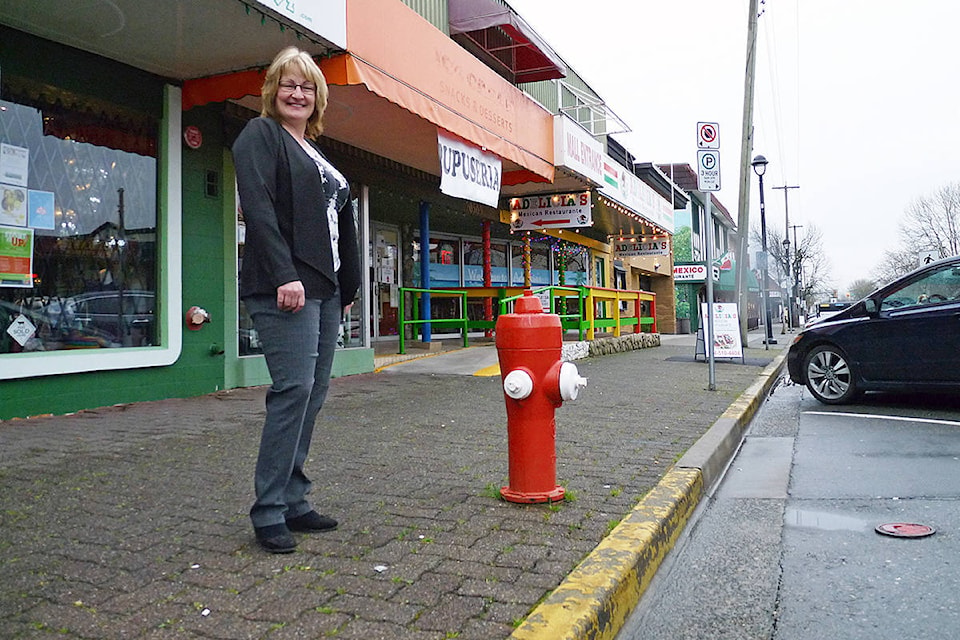A proposal that would increase available parking spaces by reducing the size of the no-parking area around fire hydrants is attracting interest from Lower Mainland municipalities.
The current five-metre limit could be cut in half with no problem, according to a University of the Fraser Valley (UFV) study carried out by Surrey Fire Chief Len Garis, who is also an adjunct professor in the School of Criminology and Criminal Justice and associate to the Centre for Social Research at UFV.
Tests carried out for the study show that reducing the no-stopping zone to 2.5 metres would increase the availability on-street parking “without impeding fire ground operations or public safety” and could create hundreds of additional parking stalls in larger communities.
Where hydrants are located in the middle of a city block, it would would allow space for an additional parking stall.
Teri James, the executive director of the Downtown Langley Business Association (DLBA) said anything that adds parking space in the downtown core would be helpful.
“I actually did wonder on more than one occasion why there was such a huge amount of space on either side of the fire hydrant,” James said.
Rick Bomhof, the Langley City Director of Engineering, Parks and Environment said reducing the clearance space around fire hydrants would likely free up a handful of parking spaces around the Kwantlen Polytechnic University campus for students and add a few spaces in the downtown core.
“Parking is always at a premium in the downtown core,” Bomhof said.
“It would be nice to have more.”
In Langley Township, where complaints about a perceived lack of parking spaces is a perennial political issue, there was cautious interest.
“We’d have to do a bigger review before we go down that road,” said Fire Chief Stephen Gamble
“We’d have to take a closer look at it,” Langley manager of transportation engineering Paul Cordeiro said.
Township mayor Jack Froese said the municipality would be looking into it further.
READ MORE: Yorkson parking report blasted by residents
The UFV study said the original reason for the existing five-metre no-stopping zone was to make it easier for fire trucks to spot the hydrants.
“With the advancement of geographic positioning systems (GPS), CAD (computer assisted design) maps in the fire trucks, and other related technologies, along with the driver’s awareness of hydrant locations, this is not widely seen as an issue any longer at least in the compact urban setting” the report stated.
The proposal has been endorsed by the association representing B.C. fire chiefs and the Regional Engineers Advisory Committee in Metro Vancouver.
The report by Garis and co-authors John Lehmann, an assistant fire chief for the City of Surrey and Alex Tyakoff, the strategic planning analyst for the City of Surrey Fire Service was released in January of 2017, but did not get a lot of attention until this week, when some engineers and managers in Lower Mainland municipalities, including Surrey and Coquitlam, started publicly discussing it as a potential solution to a shortage of parking spots.
Coquitlam councillor Craig Hodge said the city has 1,800 mid-block fire hydrants that are taking up “twice as much parking as fire chiefs say is needed,” which could be used create new spaces.
Hodge said parking has become a pressing issue because of housing prices that are leading to the creation of more secondary suites as mortgage helpers.
“Parking is the number one complaint when it comes to secondary suites,” Hodge said.
The report said shrinking the no-parking zone will require an amendment to the BC Motor Vehicle Act followed by the introduction of new local government bylaws to reflect the new provincial standard.
dan.ferguson@langleytimes.com
Like us on Facebook and follow us on Twitter
:
